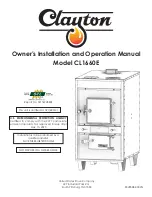
Page 90
Sequence of Operation GSR21V With GC1 Ignition Control
M−OPERATION SEQUENCE GSR21V WITH GC1 IGNITION CONTROL
This flowchart is used to show the step by step sequence that takes place when thermostat demand
is sent to the GSR21V. The sequence describes the actions of devices in the unit which control
blowers, fans, gas valve and other components in the system. The sequence is outlined by num
bered steps which correspond to circled numbers on the adjacent diagram.
NOTE−If a singlestage thermostat is to be used, HB" and W2" terminals should be jumpered
together. This forces the blower to run on the high speed heat tap and stops frequent cycling which
would occur. When the blower operates on the low speed heat/cool tap, reduced airflow causes
heat exchanger temperatures to rise above the modulation control (S78) setpoint. The upper mod
ulation limit will trip interrupting the W1 signal and energizing the blower. As the blower continues to
run and the temperatures decrease, the lower modulation limit will trip resetting the W1 signal if
there is still a call for heat.
NOTE−This is a basic operation sequence for the GSR21V. The thermostat shown is a basic elec
tromechanical thermostat .
Operation Sequence
1− Line voltage feeds through door interlock switch S51. The blower access panel must be in place to
energize the unit. (NOTE− Blower motor is always energized, S51 does not interrupt power to
blower motor.)
2− Line voltage energizes transformer T1. Transformer T1 provides 24VAC power to all unit controls,
terminal strip. Thermostat is energized after 24 VAC passes through normally closed primary limit
S10.
HeatingSingle Stage−NO JUMPERS
(APPLICATIONS WITH A SINGLESTAGE THERMOSTAT)
3− Heating demand initiates at W1 in the thermostat. Heating demand passes through modulation
control switch S78 to terminal 11 of VSP1.
4− Terminal 10 of VSP1 energizes ignition control A3 passing through N.C. differential pressure
switch S72. External Watchguard is enabled. Watchguard will break and remake signal to VSP1
every 60 + 5 minutes of heating call.
5− Combustion air blower B6 is energized for 30 + 2 seconds by ignition control A3.
6− Gas valve GV1 is energized by terminal 3 of ignition control A3.
7− Attempts for ignition occur.
8− After ignition is sensed, GC1 continues sparking and the combustion air blower is energized for
the remaining time of the ignition attempt.
9− Combustion air blower B6 is deenergized.
10− VSP1 internal circuitry starts blower on low speed heat/cool tap after a 45 second delay. After
approximately 3−10 minutes heat exchanger temperatures will have risen to the set point of modu
lation control S78.
11− S78 will open, interrupting signal to VSP1 and in turn ignition control A3 is deenergized closing
gas valve.
12− Combustion air blower B6 is energized for 30 + 2 seconds by ignition control A3.
13− VSP1 internal circuitry forces blower to operate on low speed heat/cool tap, reducing heat ex
changer temperature.
14− When heat exchanger temperature falls below the modulation control set point, modulation limit
S78 closes and signal to VSP1 is remade. If there is still a call for heat, unit will attempt ignition and
operate until S78 cycles again.
HeatingSingle Stage HB Jumpered to W2
(APPLICATIONS WITH A SINGLESTAGE THERMOSTAT)
15− The thermostat calls for heat (W1). Ignition is established. See steps 3−8.
16− Internal circuitry of the VSP1 forces the blower to run on high speed heat tap when HB and W2 are
jumpered together via the field installed jumper. Blower operates on high speed heat tap.
17− Heat exchanger temperatures are kept below modulation control S78 opening set point. Modula
tion control S78 is now acting as a safety limit.
HeatingTwo Stage
(APPLICATIONS WITH A TWOSTAGE THERMOSTAT)
Stage One:
18− The thermostat calls for heat (W1). Ignition is established. See steps 3−8.
19− The unit operates in the first stage of heating. See steps 913.
Stage Two:
20− The thermostat calls for heat (W2). Ignition is established. See steps 3−8.
21− Pin 6 of VSP1 is energized. Internal circuitry of the VSP1 forces the blower to run on high speed
heat tap.
22− Heat exchanger temperatures are kept below modulation control S78 opening set point.
HeatingZone Control System Used−HB NOT Jumpered to W2
Stage One:
23− The thermostat calls for heat (W1). Ignition is . See steps 3−8.
24− When the Harmony Zone Control System is used, the motor does not run at the low speed heat/
cool or the high speed heating tap. Zone controller internal circuitry provides the DS terminal (Pin
4) to control blower speed based upon zone demands. Speed is determined by a PWM signal.
Blower speed is based on the PWM signal determined by the number of zones calling.
End of Heating Demand:
25− Heating demand is satisfied. Ignition control A3 is de−energized. Gas valve GV1 closes. Pulse
cycle stops.
26− Combustion air blower B6 is energized for 30 + 2 seconds by ignition control A3.
27− VSP1 internal circuitry continues to power blower motor B3 on low speed heat/cool tap for the
adjustable time 90−330 seconds. After the adjustable delay, B3 is de energized.
Blower Only:
28− Blower demand G originates in the thermostat. Terminal 2 of VSP1 is energized.
29− VSP1 internal circuitry forces blower to operate on low speed heat/cool tap. Blower operates on
low speed heat/cool tap.
CoolingSingle Stage−No CCB1, No Harmony, DS Jumpered to G
(APPLICATIONS WITH A SINGLESTAGE THERMOSTAT)
30− Refer to table 22 for operation characteristics.
CoolingTwo StageNo CCB1, No Harmony, DS Jumpered to Y2
(APPLICATIONS WITH A TWOSTAGE THERMOSTAT)
Stage One:
31− Refer to table 22 for operation characteristics.
Stage Two:
32− Refer to table 22 for operation characteristics.
CoolingCCB1 Used with SingleSpeed or TwoSpeed Compressor, No Harmony,
No Jumpers
33− Refer to table 22 for operation characteristics.
CoolingHarmony Zone Control Used With SingleSpeed or TwoSpeed Compressor,
No CCB1, No Jumpers
34− Refer to table 22 for operation characteristics.










































